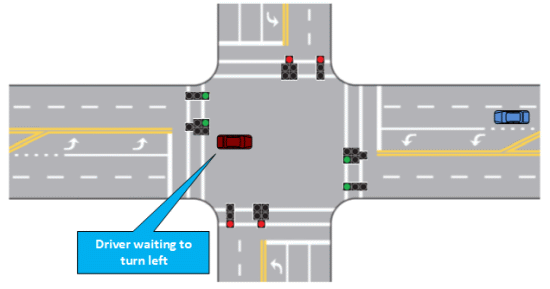|
||
|
|
||
This page last updated February 12, 2024 |
 Over the past few years, the implementation of the flashing yellow arrow (FYA) traffic signal has become widespread. While the meaning of the signal is generally well-understood ("yield to turn left"), the reason for its replacement of previous "permissive left" signals is not widely understood, with some cynics asserting it to be an intentional waste of money. This page is intended to explain the reason why the signal was developed, and why it is superior to previous permissive left signals.
Over the past few years, the implementation of the flashing yellow arrow (FYA) traffic signal has become widespread. While the meaning of the signal is generally well-understood ("yield to turn left"), the reason for its replacement of previous "permissive left" signals is not widely understood, with some cynics asserting it to be an intentional waste of money. This page is intended to explain the reason why the signal was developed, and why it is superior to previous permissive left signals.
(A "permissive left" is when a signal permits you to turn left but the turn is not protected.)
|
ADVERTISEMENT |

Sometimes in this situation, a driver will instead smartly opt to wait for oncoming traffic to actually stop, or may somehow know that oncoming traffic does still have a green, and so they will then continue to wait in the intersection while their light turns red. However, sitting in an intersection with a red light often leads the driver to quickly become anxious, making them prone to take more risky turns, or they will try to back out of the intersection, both of which are undesirable outcomes.

Traffic engineers in Dallas came up with what is regarded as the first signalized solution. With conventional permissive left turns, the left turn signal shows the same circular signal as the adjacent through signals (see first example below). In other words, when northbound through traffic has a green, the northbound left turn also shows the same corresponding green circular signal, and the same for red. The Dallas solution was to de-couple the left turn permissive signal from the adjacent through signal and instead sync it with the opposing through signal. That way, when the northbound left turn signal was turning red, the southbound through signal was also turning red at the same time, therefore meeting the northbound left-turning motorist's expectation that opposing traffic will stop and thus allowing them complete their turn safely. This became known as "Dallas Phasing".
(Confused? Watch the animated comparison of left turn signals in the first site under "Other sites of interest" at the bottom of this page.)
A side benefit of Dallas phasing was that there was increased time for left turns, which helped move more vehicles through the intersection each cycle, thus helping to ease congestion.
To accommodate this change using existing signal displays, engineers had to install louvers in the green circular signal for the left turn so that the adjacent through traffic would not see it and perhaps get confused (see second example below). These louvers worked reasonably well for that purpose, but also reduced the visibility of the green signal markedly, especially if the signal got out of alignment or was on a span wire and being blown by the wind. So it was less than ideal.
Another problem, though, was that some drivers became confused when seeing red signals for the adjacent through traffic but a green signal for the left turn lane. Because drivers are accustomed to usually seeing this when they have a protected left, many drivers — either due to instinct and/or not paying close attention — started turning before recognizing that the green signal was not actually an arrow and that they in fact were supposed to yield. The results of this were often disastrous.


In driver comprehension studies, the FYA was found to have a high inherent understanding. Perhaps more importantly, drivers who did not understand its meaning tended to interpret it to mean "wait" (i.e. a "safe failure"), whereas with the green circular signal, drivers who misunderstood it usually interpreted it as a protected turn (i.e. a "critical failure").
The FYA also provided a signal indication that was exclusive for left turns, i.e. it obviously had no meaning for through drivers, so therefore seeing it would not possibly cause confusion for through drivers. This eliminated the need for louvers.
And the FYA proved to be more versatile and flexible in terms of possible signal displays and operation than the other displays studied.
Based on the results of the studies, the FYA was field tested beginning in 2006 in localities in Maryland, Oregon, Florida, and Arizona. Those tests confirmed that the FYA solved the Yellow Trap and did so with a generally-understood signal that, when misinterpreted, typically resulted in a safer default outcome. As a result, the signal was approved for general use in the 2009 Manual on Uniform Traffic Control Devices, and Dallas displays were prohibited for new installations.
In short, here are the benefits of the FYA:
- Solves the Yellow Trap.
- Uses a signal that is generally well-understood.
- Uses a signal that, if not understood, usually results in a safe outcome.
- Uses a signal that is flexible and can be used universally.
- Uses a signal that is exclusive for left turns.
- Increases left turn capacity, thus helping to reduce congestion and driver frustration.
- Reduces crashes.
Other sites of interest


